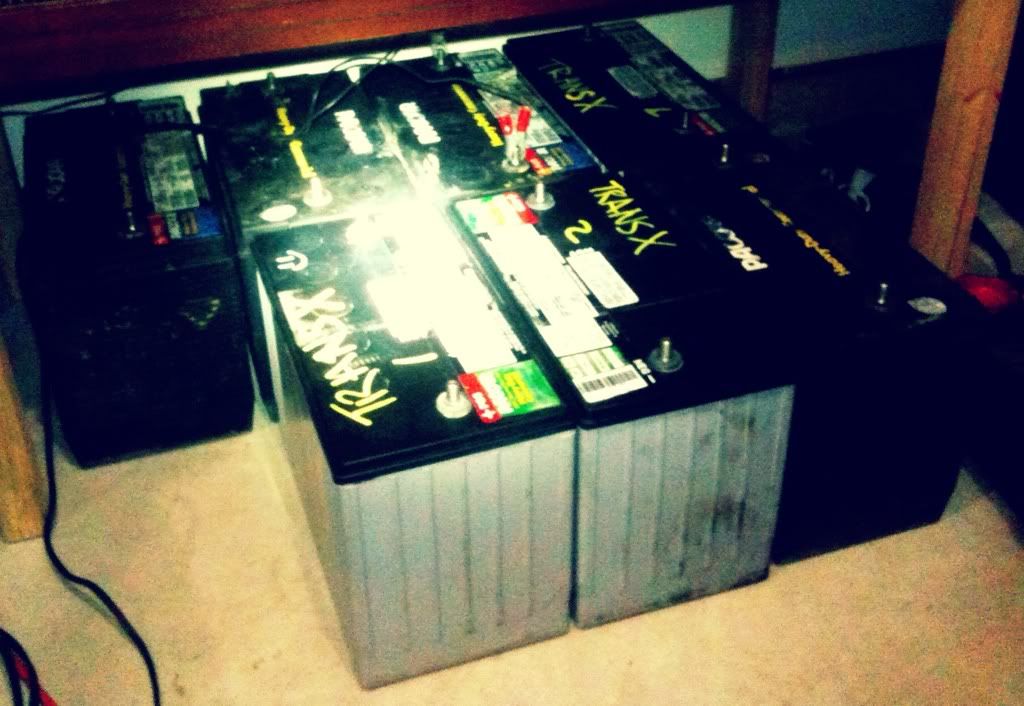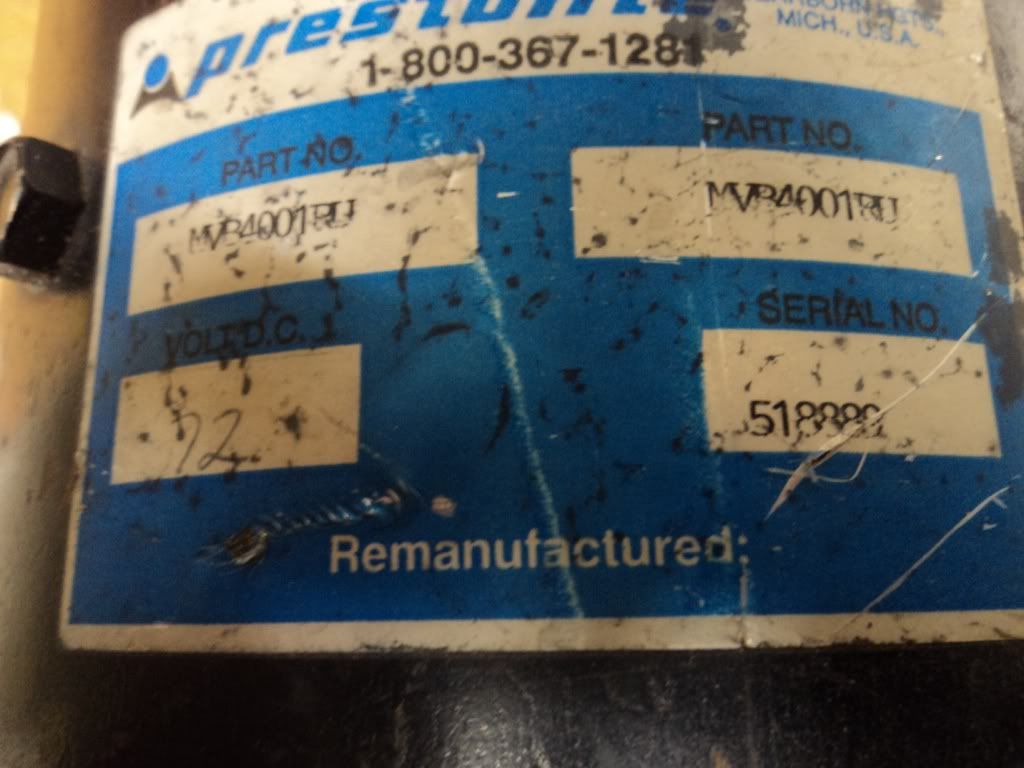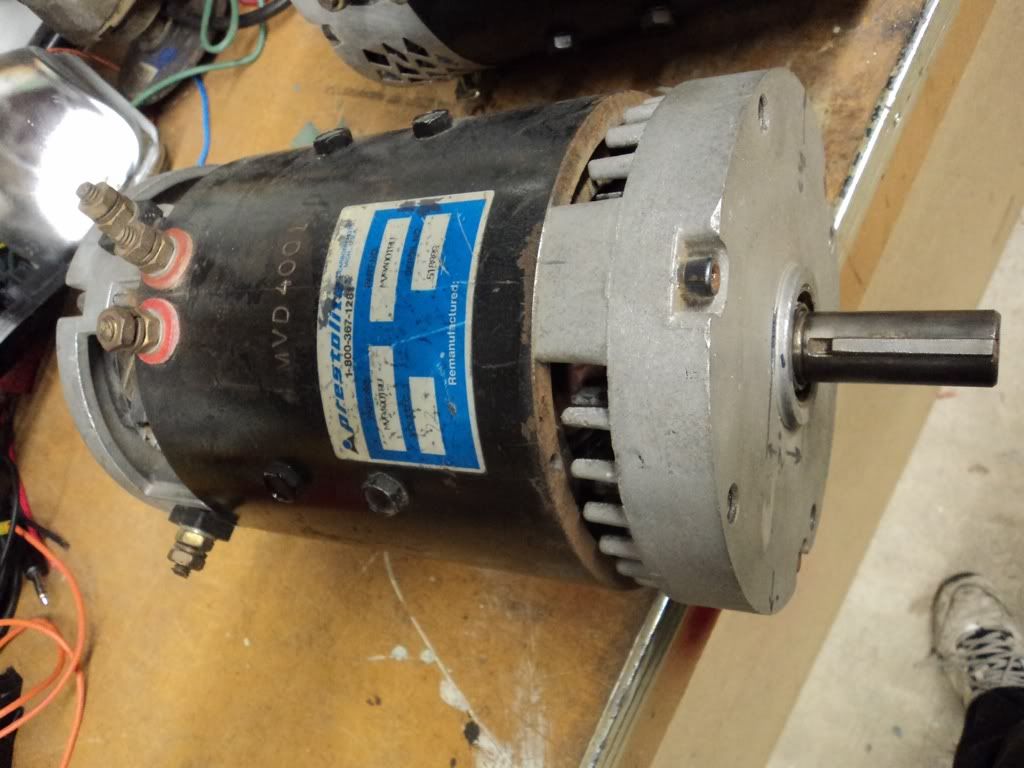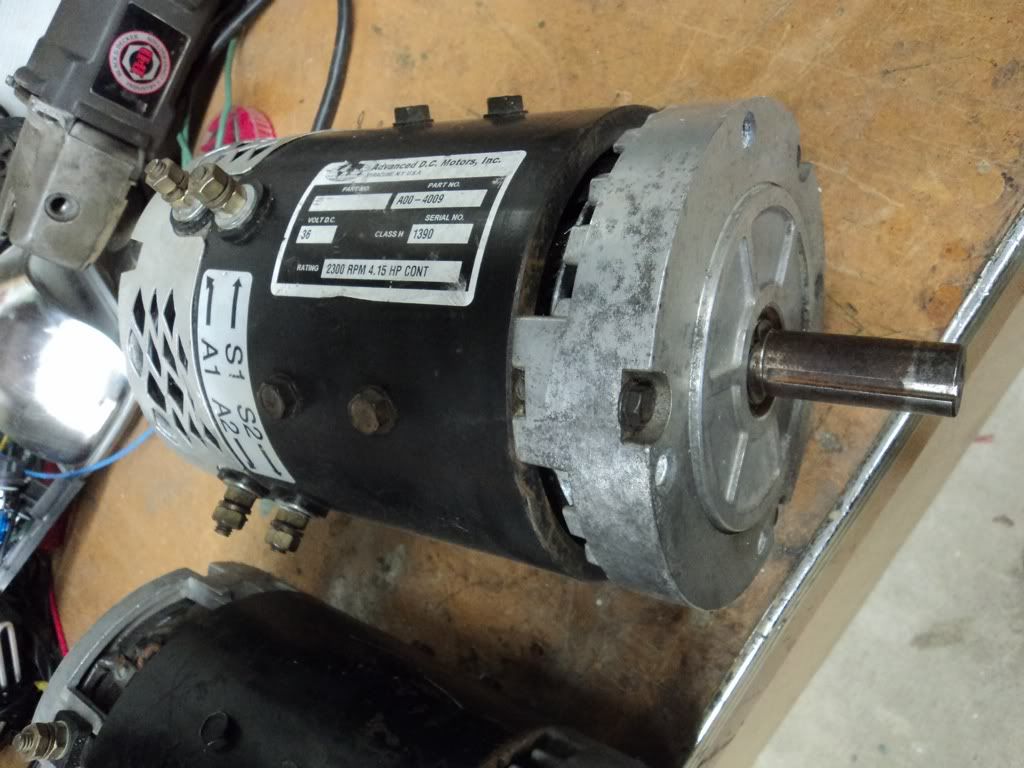 01-12-2012, 10:24 PM
01-12-2012, 10:24 PM
|
#21 (permalink)
|
|
Ford Escort 2.0
Join Date: Feb 2008
Location: Alameda, CA
Posts: 240
Thanks: 6
Thanked 27 Times in 24 Posts
|
I think your decision to go for something more than a 7245 is a good idea. I have a 7245, and at 1300 pounds of vehicle weight it is fun, but with anything heavier it would probably be sluggish.
With lead acid batteries, you're only going to be able to pull about 500 to 600 amps out of a single series string before voltage sag gets too great.
The Curtis 1221C is a 120v 400a controller, but a few people I've known complain that they tend to cut back to a much lower amperage setting (300 amps or so) after a few seconds. At 300 amps, a 120v pack is putting out about the same power as a 72v pack at 500 amps. The Alltrax 7245 is only rated for 450 amps, but my Alltrax reports well over 500 amps, and doesn't really ever heat up or have a cut back problem.
The 1231C is a 500 amp, 144v controller. It will also tend to cut back to 350 to 400 amps after it heats up, but at 144v you have more to begin with.
__________________

|
|
|

|
|
The Following 2 Users Say Thank You to TomEV For This Useful Post:
|
|
 Today Today
|
|
|
|
 Other popular topics in this forum...
Other popular topics in this forum...
|
|
|
|
 01-13-2012, 04:02 AM
01-13-2012, 04:02 AM
|
#22 (permalink)
|
|
Master EcoModder
Join Date: Jul 2008
Location: Langley, BC
Posts: 1,228
Fusion - '16 Ford Fusion Hybrid SE
Thanks: 190
Thanked 275 Times in 168 Posts
|
TomEV, what you say all makes sense. Do you think two controllers like I diagrammed above (post #19) would work? I just need to know whether the field windings have the same resistance as the armature windings. I need a current EVer to do the simple voltmeter test I mentioned in that post. If I choose to go with commercial controllers, it would save a pile of money. Two used Alltrax 48V 500A controllers for a total of $500 vs one Curtis higher voltage controller for $800 or more. These are just numbers....I really have no idea.
Anybody want to donate a controller? HA!
How about a picture of my current battery stash....

Last edited by mechman600; 01-13-2012 at 04:15 AM..
|
|
|

|
 01-13-2012, 11:19 AM
01-13-2012, 11:19 AM
|
#23 (permalink)
|
|
Administrator
Join Date: Dec 2007
Location: Germantown, WI
Posts: 11,203
Thanks: 2,501
Thanked 2,590 Times in 1,556 Posts
|
I asked the local EV club here your question about using two controllers. The replies were that you probably can do it, but it will not work well and certainly won't be as efficient. Apparently the resistance of each coil is not going to be the same, and you would want some way to try and sync them up which would be a lot of extra hassle. The PWM timing may also mess with the efficiency.
|
|
|

|
|
The Following User Says Thank You to Daox For This Useful Post:
|
|
 01-13-2012, 11:08 PM
01-13-2012, 11:08 PM
|
#24 (permalink)
|
|
Ford Escort 2.0
Join Date: Feb 2008
Location: Alameda, CA
Posts: 240
Thanks: 6
Thanked 27 Times in 24 Posts
|
Not sure if this answers your question, but I just tested the spare 6.7" GE 3.5 HP series motor I have. Here are the results:
Field resistance: .22 ohms
Armature resistance: .34 ohms (varies as the armature is turned, but generally settles in to around .34 when not moving)
Using a 12v power source from a portable jumper battery pack (12v, 19aH gel battery) the motor turns about 3,000 RPM unloaded when configured in series. (power in at A1, A2 and S2 jumpered, power out at S1 - this motor 'normal' rotation is reverse from most other motors).
Using this battery, the voltage across the armature posts (A1, A2) is 11.31 volts. Voltage across the field is .191 volts. Running voltage from the battery + and - is 11.47 volts. Amperage was not measured, but probably about 40 amps.
In simulating two controllers (one battery to the field, another to the armature) the motor would not self-start, and the brushes made complaining noises and got hot.
Starting the motor in series mode up to about 3,000 RPM, I quickly reconfigured the power as the motor coasted down, with one 12v battery powering the field, and another powering the armature. This time, the motor accelerated to much faster than 4,000 RPM (estimate), probably because the field battery happened to be weaker than the armature battery (quasi field weakening).
Based on these observations, I believe the two controller setup will not start the motor from a dead stop, but could be useful to reduce back EMF in order to make a fully loaded motor run faster at relatively high RPM. It would be complicated to make a second controller weaken the field enough to control the motor RPM and not induce too much current across the armature. Probably much easier to just make up a simple weakening resistor that is switched in and out as needed.
Additional complications may be synchronizing the timing pulses of the two controllers, although at 20 kHz (artificial DC to a motor) it may not make a difference.
__________________

|
|
|

|
|
The Following 2 Users Say Thank You to TomEV For This Useful Post:
|
|
 01-13-2012, 11:45 PM
01-13-2012, 11:45 PM
|
#25 (permalink)
|
|
Master EcoModder
Join Date: Jul 2008
Location: Langley, BC
Posts: 1,228
Fusion - '16 Ford Fusion Hybrid SE
Thanks: 190
Thanked 275 Times in 168 Posts
|
WOW...Thanks! Now we know. It's totally weird that most of the voltage drop was across the armature, but I suspected something weird like that would occur. I guess it's the product of the back EMF, especially considering that you did those checks at max RPM when back EMF basically equals voltage going in.
As far as PMW pulses go, are those not mostly absorbed by the ridiculously large capacitors in the controller anyway? I guess that's neither here nor there anymore. If I can't find a cheap higher voltage controller in the next few months I will probably look at buying the Open Revolt kit.
Put it this way: if two controllers on a split motor was the magical answer, everyone would be doing it!
|
|
|

|
 01-15-2012, 06:23 PM
01-15-2012, 06:23 PM
|
#26 (permalink)
|
|
Master EcoModder
Join Date: Jul 2008
Location: Langley, BC
Posts: 1,228
Fusion - '16 Ford Fusion Hybrid SE
Thanks: 190
Thanked 275 Times in 168 Posts
|
Two Motors in Question
I know I may get a free forklift motor if my local forklift company gets a unit in that they are going to scrap. But I have contacted a local guy here who has an ad on the VEVA website with some parts. He has two motors that interest me, both $350 CDN each.
One is a Prestolite. The tag says MVB 4001, but etched into the case is MVD 4001. It weighs 57 lbs, according the scale in one picture he sent me.


The other motor is an Advanced A00-4009. According to EV parts sites, they are 50 lbs.

Specs here:
Motor AMD 6.7" #A00-4009 36-72VDC 6HP Single Shaft
These are the sort of motors I was expecting to use, even though I know they are both tiny for a 2400 lb car. I am leaning towards the Advanced motor because it is used all the time in EV applications. With some forced cooling and short range (not running it long enough to heat up anyway), would it survive? Does anyone have experience with the Prestolite in abusing applications? Keep in mind that BUDGET is first on my requirements list. |
|
|

|
 01-15-2012, 09:16 PM
01-15-2012, 09:16 PM
|
#27 (permalink)
|
|
Master EcoModder
Join Date: Jan 2008
Location: Western Wisconsin
Posts: 3,903
Thanks: 867
Thanked 434 Times in 354 Posts
|
The Advanced DC motor is about the size that my 1,400 pound commuti-car uses and it seems like a perfect sized motor for a motorcycle, I would worry about burning it up in a heavier car.
I would aim for a 9" motor if you can get one, if that 6.7" motor was cheap or free then I would say go for it! but as it is I think it's undersized and even the Advanced DC K91-4003 motor that is about the same size but rated for a higher voltage so they give specs for those higher voltages puts out a peek of 29hp and a continues 10hp at 96v, so you would be working that motor really hard to get it to move a full sized car down the road.
|
|
|

|
 01-16-2012, 10:06 AM
01-16-2012, 10:06 AM
|
#28 (permalink)
|
|
Master EcoModder
Join Date: Apr 2009
Location: Charlton MA, USA
Posts: 463
Thanks: 31
Thanked 183 Times in 94 Posts
|
I have an A00-4009 in my golf cart with 25" tires and direct drive. The rear end ratio is 12.5:1. The cart weighs about 1200-1300lbs and can really heat the motor. I dont see how this motor would be big enough for anything bigger then a citi car.
-Adam
|
|
|

|
|
The Following User Says Thank You to adamj12b For This Useful Post:
|
|
 01-17-2012, 12:55 AM
01-17-2012, 12:55 AM
|
#29 (permalink)
|
|
Master EcoModder
Join Date: Jul 2008
Location: Langley, BC
Posts: 1,228
Fusion - '16 Ford Fusion Hybrid SE
Thanks: 190
Thanked 275 Times in 168 Posts
|
Controller!
Ok, so I may have...I mean...I have...er...purchased a controller on eBay. I COULDN'T HELP IT! An Alltrax 7245. I know I know, too small. But it was such a good deal - $306 with free shipping, and it is apparently new. So, it will be my temporary controller so I can get a "feel" for the whole EV thing. I can always upgrade later and get what I paid for it if I sell it.

Needless to say, I am ridiculously excited. It is, after all, my very first conversion purchase, other than the 12V charger I ordered (that could be considered just another tool for the garage). So far it has been free battery collecting - very little commitment required. But now it's official: I am spending money on it.
Oh, and I am up to 9 batteries in the garage. I'd better stop collecting soon or the wife will notice. HA! |
|
|

|
 01-21-2012, 03:13 AM
01-21-2012, 03:13 AM
|
#30 (permalink)
|
|
Master EcoModder
Join Date: Jul 2008
Location: Langley, BC
Posts: 1,228
Fusion - '16 Ford Fusion Hybrid SE
Thanks: 190
Thanked 275 Times in 168 Posts
|
Chargers!

A picture is worth a thousands words. In this case, 290.
Canadian Tire, 1/2 price for $30 + tax (12% sales tax here. Yes folks, that is correct....12%), so I got six of them. I brought my multimeter to the store to make sure they are isolated, checking for continuity between the input and output side: OL. At home I hooked two chargers up to a couple of batteries and checked for voltage differences between the positive of one battery and negative of the other battery, negative and positive, positive to positive and negative to negative (overkill just to make sure): OL. Then I just took a wire and did the same, looking for a spark: nope. All good news.
My reason for choosing individual chargers isn't because of cost, although these were pretty cheap (and I do have another Schumacher one coming from Amazon as well). I could have bought a used 72V or 84V charger for pretty cheap, after all. The reason is because I have a wildly mismatched selection of batteries (older floodies, newer floodies, AGM's, etc.), and charging them in series without doing damage would be very challenging, if possible at all.
So the chargers. 10/2A. Auto shut off. El-cheapo Chinese made. Some watching with my voltmeter shows that on "automatic conventional & low maintenance" mode, they charge until 15.0V and then shut off with a continuing trickle charge. When the voltage falls below about 12.9V they turn back on. On the "maintenance-free & deep-cycle" mode, shutoff is 15.4V and turn on is 13.0V. Now to choose which mode to use. I think the lower voltage one for the "dual-purpose" floodies and the higher voltage for the AGMs. Can a battery know-it-all please chime in here?
|
|
|

|
|